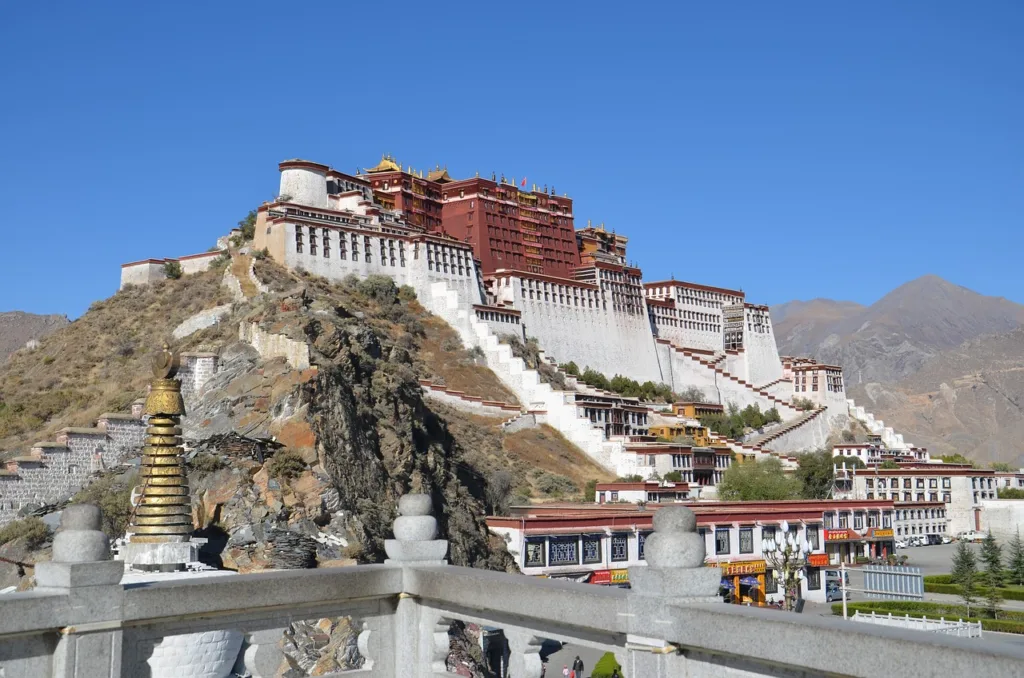
Lhasa's beautiful Potala Palace, once home to the Dalai Lama
Tibet, also known as the “Roof of the World,” is a landlocked region in Central Asia. It is a part of China, covering an area of over 1.2 million square kilometres, with an average elevation of more than 4,000 meters above sea level. Tibet is a land of diverse landscapes, ranging from the snow-capped Himalayas in the south to the vast high-altitude plateau in the north. It is home to some of the world’s highest peaks, including Mount Everest, which stands at 8,848 meters.
The Tibetan Plateau is the world’s highest and largest plateau, covering an area of over 2.5 million square kilometres. It is surrounded by towering mountains, including the Himalayas, the Kunlun Range, and the Karakoram Range. The plateau is also the source of many of Asia’s major rivers, including the Mekong, Yangtze, and Yellow rivers, which provide water to more than one billion people.
The history of Tibet dates back to the 7th century when the Tibetan Empire was founded by King Songtsen Gampo. Over the centuries, Tibet has been an independent kingdom, a part of China, and a protectorate of the British Empire. In 1950, the People’s Republic of China claimed sovereignty over Tibet, leading to a period of conflict and resistance.
The Tibetan culture is unique and rich, shaped by its isolation and harsh environment. Tibetan Buddhism, which was introduced in the 7th century, is an integral part of Tibetan culture and way of life. The Dalai Lama, the spiritual leader of Tibetan Buddhism, is revered by Tibetans and Buddhists around the world.
Tibetan art, music, and literature are also distinct and have influenced the surrounding regions. Tibetan thangkas, intricate paintings of silk or cotton, are famous for their religious significance and beauty. Tibetan music is characterized by unique instruments, such as the dranyen and the dungeon, and chanting. Tibetan literature includes works of history, philosophy, and poetry.
Tibetan cuisine is also distinctive, featuring hearty and warming dishes suited to the cold climate. Yak meat, barley, and butter are stapled ingredients in many Tibetan dishes, including momos (dumplings) and tsampa (roasted barley flour). Tibetan tea, made with yak butter, salt, and tea leaves, is a traditional drink and is often served as a sign of hospitality.
Despite its rich cultural heritage, Tibet faces many challenges today. The Chinese government’s policies towards Tibet, including restrictions on freedom of religion and speech, have been criticized by human rights organizations. The environmental impact of development on the Tibetan Plateau, including mining and dam construction, has also been a concern.
Read the Seven Years in Tibet book to see the full panoramic view of Tibet.
The Early History of Tibet & the Cultural Connection with India
The early history of Tibet is shrouded in mystery and legend, but archaeological and historical evidence suggests that Tibet was inhabited as early as the Neolithic period, around 8000 BCE. The first recorded kingdom of Tibet was the Yarlung Dynasty, which ruled from the 5th century CE until the 9th century CE. This dynasty is credited with the introduction of Buddhism to Tibet, which had a profound impact on the region’s culture and history.
The Yarlung kings were believed to be of royal descent and were known as the “Bodhisattva Kings.” They were patrons of Buddhism and built many temples and monasteries throughout Tibet. They also established a system of government that was based on Buddhist principles, with the king serving as both a spiritual and political leader.
One of the most famous Yarlung kings was Songtsen Gampo, who ruled from 618 to 650 CE. He is credited with the unification of Tibet and the expansion of the kingdom’s borders. He also married two princesses from neighbouring kingdoms, one from China and one from Nepal, which helped to establish diplomatic and cultural ties with these regions.
Under Songtsen Gampo’s rule, Tibet began to adopt many elements of Indian culture, including Buddhism, the Sanskrit language, and literature. He is believed to have commissioned the translation of many Buddhist texts into Tibetan and built many temples and monasteries, including the famous Jokhang Temple in Lhasa, which is still considered one of the most sacred sites in Tibet.
The cultural connection between Tibet and India continued to grow under the rule of the Tibetan Empire, which lasted from the 7th century to the mid-9th century. The empire was founded by King Songtsen Gampo’s descendants, and it was during this period that Buddhism became firmly established in Tibet.
Many Indian Buddhist masters, such as Padmasambhava, also known as Guru Rinpoche, and Atisha, travelled to Tibet and helped to establish and spread the teachings of Buddhism. They brought with them many Indian cultural and religious practices, including the use of the Sanskrit language and the creation of elaborate mandalas and thangkas.
Tibetan Buddhism, as it evolved under Indian influence, became a unique and distinct form of Buddhism, with its own rituals, practices, and teachings. It emphasizes the importance of compassion, wisdom, and mindfulness, and incorporates elements of Tibetan shamanism and Bon, an indigenous religion of Tibet.
In conclusion, the early history of Tibet is closely linked to the introduction of Buddhism and the cultural connection with India. The Yarlung Dynasty, particularly King Songtsen Gampo, played a key role in establishing this connection and building the foundations of Tibetan culture. The influence of Indian culture on Tibet is evident in the adoption of Buddhism, the Sanskrit language, and literature, and the development of a unique form of Tibetan Buddhism. This cultural connection continues to be an important part of Tibetan identity and history today.
Tibet and India
Tibet has had a long and complicated relationship with India. The two countries share a border that stretches over 2,500 kilometres, and their histories have been intertwined for centuries. Buddhism, which is the predominant religion in Tibet, was introduced to the region from India in the seventh century CE. Indian Buddhist scholars and teachers played a key role in the development of Tibetan Buddhism.
The relationship between Tibet and India was further strengthened in the eighth century CE when the Indian monk Padmasambhava travelled to Tibet and helped to establish the Nyingma school of Tibetan Buddhism. Padmasambhava is considered to be one of the most important figures in the history of Tibetan Buddhism and is revered as a saint in both Tibet and India.
Tibet and India maintained close cultural and religious ties in the centuries that followed. Tibetan monks travelled to India to study Buddhism, while Indian scholars and teachers travelled to Tibet to spread their teachings. This exchange of knowledge and ideas helped to shape Tibetan culture and played a key role in the development of Tibetan Buddhism.
The relationship between Tibet and India was not always peaceful, however. In the ninth century CE, Tibetan armies invaded northern India and established the Kingdom of Guge. The Guge Kingdom lasted for several centuries and was known for its cultural and artistic achievements. However, it was eventually conquered by the neighbouring kingdom of Ladakh.
In the centuries that followed, Tibet and India continued to have a complicated relationship. Tibet was at times a vassal state of China, while India was ruled by a series of empires and kingdoms. However, throughout this time, the cultural and religious ties between the two countries remained strong.
The Modern History of Tibet
The modern history of Tibet is marked by the Chinese invasion and annexation of Tibet in 1950. Prior to this, Tibet had been a theocratic state, with the Dalai Lama serving as both the spiritual and political leader of Tibet. However, the Chinese government claimed that Tibet was a part of China and used military force to assert its control over the region. This led to the flight of the Dalai Lama and tens of thousands of Tibetans to India and other neighbouring countries in 1959, where they established a government-in-exile in the city of Dharamshala.
Dharamshala, located in the northern state of Himachal Pradesh in India, has since become the centre of the Tibetan community in exile. The city serves as the capital of the Tibetan government-in-exile and is home to the Dalai Lama’s official residence and office, as well as numerous monasteries, temples, and cultural institutions.
Since his exile, the Dalai Lama has been a vocal advocate for Tibetan rights and independence and has worked tirelessly to promote awareness of the situation in Tibet and to gain support for the cause of Tibetan autonomy. He has travelled extensively, giving talks and lectures on the importance of compassion, peace, and nonviolence.
Despite international pressure and calls for greater autonomy for Tibet, the Chinese government has continued to maintain tight control over the region, and human rights abuses, including forced resettlement, torture, and restrictions on religious freedom, have been widely reported. In response, the Tibetan government-in-exile and its supporters have continued to advocate for the rights of Tibetans and for the return of the Dalai Lama and other exiled Tibetans to their homeland.
In recent years, there have been efforts to renew talks between the Chinese government and representatives of the Tibetan government-in-exile, but progress has been slow. The situation in Tibet remains a contentious issue, and the struggle for Tibetan independence continues to be an important part of modern Tibetan history. Despite the challenges faced by the Tibetan community in exile, the city of Dharamshala has become a symbol of hope and resilience for Tibetans around the world.
If you want to learn more about Tibet, go through the phenomenal book Seven Years in Tibet by Heinrich Harrer. Click Here to purchase.







Amazing fact
Good content in simple language
Crisp and short 😊
Every sentence feels like a key unlocking something new and valuable.